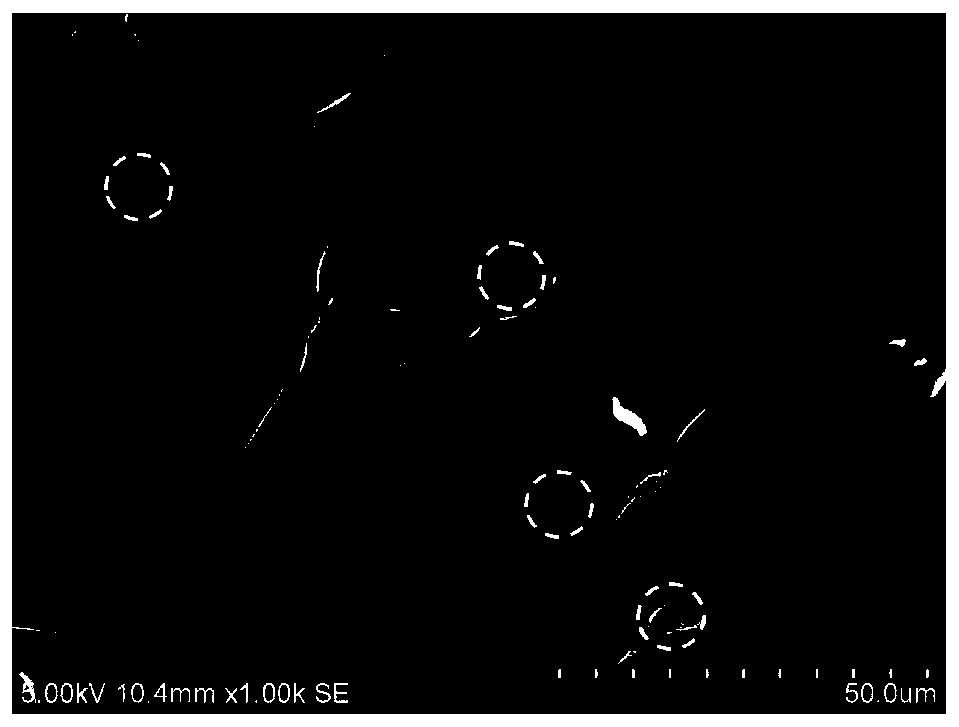Antibacterial hydrogel with controllable released nano silver ions and preparation method thereof
A nano-silver particle and hydrogel technology, which is applied in the field of biomedical engineering composite biomaterials, can solve the problems that implants cannot achieve antibacterial or antibacterial effects, and achieve the goals of improving toxicity, long-term antibacterial effects, and promoting repair and regeneration. Effect
- Summary
- Abstract
- Description
- Claims
- Application Information
AI Technical Summary
Problems solved by technology
Method used
Image
Examples
Embodiment 1
[0044] Preparation of an antibacterial hydrogel with controllable release of nano silver ions:
[0045] 1) Mix the modified nano-silver-loaded microspheres and UV-sensitive modified gelatin with a mass fraction of 8% according to a mass ratio of 1:40 to form a prepolymer solution, and add photoinitiator 2-hydroxyl to the prepolymer solution - 4′-(2-hydroxyethoxy)-2-methylpropiophenone is mixed evenly, and the mass volume ratio (w / v) of the photoinitiator to the prepolymer solution is 1%.
[0046] 2) After repeatedly blowing and mixing the solution obtained in 1), take 150 μl of the solution and drop it into the photocrosslinking model, and place it under ultraviolet light (wavelength of external light source: 320-480nm, power of ultraviolet point light source: 7.0mW / cm 2 ) under cross-linking for 30 seconds and then removed to obtain an antibacterial hydrogel.
Embodiment 2
[0048] 1) Mix the modified nano-silver-loaded microspheres and UV-sensitive modified gelatin with a mass fraction of 8% according to the mass ratio of 1:80 to form a prepolymer solution, and add photoinitiator 2-hydroxyl to the prepolymer solution -4′-(2-hydroxyethoxy)-2-methylpropiophenone is mixed evenly, and the mass volume ratio (g / ml) of the photoinitiator to the prepolymer solution is 1%.
[0049] 2) After repeatedly blowing and mixing the solution obtained in 1), take 150 μl of the solution and drop it into the photocrosslinking model, and place it under ultraviolet light (wavelength of external light source: 320-480nm, power of ultraviolet point light source: 7.0mW / cm 2 ) under cross-linking for 30 seconds and then removed to obtain an antibacterial hydrogel.
Embodiment 3
[0051] 1) Mix the modified nano-silver-loaded microspheres and UV-sensitive modified gelatin with a mass fraction of 8% according to the mass ratio of 1:160 to form a prepolymer solution, and add photoinitiator 2-hydroxyl to the prepolymer solution -4′-(2-hydroxyethoxy)-2-methylpropiophenone is mixed evenly, and the mass volume ratio (g / ml) of the photoinitiator to the prepolymer solution is 1%.
[0052] 2) After repeatedly blowing and mixing the solution obtained in 1), take 150 μl of the solution and drop it into the photocrosslinking model, and place it under ultraviolet light (wavelength of external light source: 320-480nm, power of ultraviolet point light source: 7.0mW / cm 2 ) under cross-linking for 30 seconds and then removed to obtain an antibacterial hydrogel.
[0053] The antimicrobial hydrogel with controllable release of nano-silver ions obtained in Example 2 when the mass ratio of modified microspheres to gelatin was 1:80 was analyzed by scanning electron microscop...
PUM
| Property | Measurement | Unit |
|---|---|---|
| Diameter | aaaaa | aaaaa |
| Height | aaaaa | aaaaa |
| Wavelength | aaaaa | aaaaa |
Abstract
Description
Claims
Application Information
 Login to View More
Login to View More - R&D
- Intellectual Property
- Life Sciences
- Materials
- Tech Scout
- Unparalleled Data Quality
- Higher Quality Content
- 60% Fewer Hallucinations
Browse by: Latest US Patents, China's latest patents, Technical Efficacy Thesaurus, Application Domain, Technology Topic, Popular Technical Reports.
© 2025 PatSnap. All rights reserved.Legal|Privacy policy|Modern Slavery Act Transparency Statement|Sitemap|About US| Contact US: help@patsnap.com



